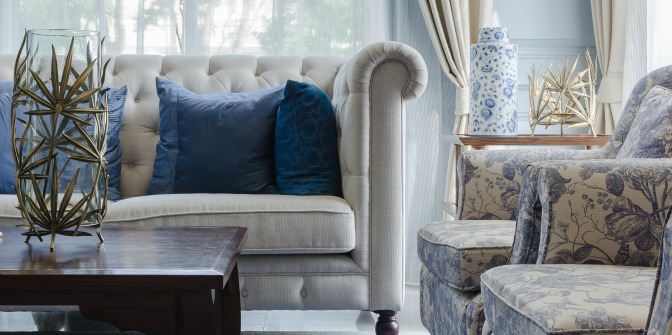Every interior decorator has been there: standing in your client’s house, staring at one of their rooms, and struggling to figure out what on earth is wrong with it. It looks okay, but somehow it just falls flat. Something’s missing—you just can’t tell what.
Whether you’re looking at the client’s original room or your own almost-finished work, it’s frustrating to get stuck on a missing detail you can’t quite pin down. What you need is a way to break down the room until you can work out what exactly isn’t working.
Our solution? The ultimate interior decorator’s checklist.
How it works
Our checklist is actually more like a scorecard. We’ve broken down room design into some of its most general elements and given each a numbered score. For each room, narrow your focus to each of these elements in turn and decide how to score it. Then add up your points and see how you score out of 21.
A little short of the mark? Clearly the room is missing something. Go back to your checklist and see where you scored the lowest. Maybe your client’s living room doesn’t jive with you because it’s missing some ambient lamps. Maybe the bathroom is blah because your client didn’t bother to install any artwork.

Whatever the problem, our checklist helps you zero in on it for an easy fix. And hey, even if you’re scoring pretty well, there’s always room for improvement!
So, without further ado…
The Interior Decorator’s Checklist
Lighting
Good lighting can transform a room, while bad lighting can hide all its best features and leave it looking drab.
- 1 point for good ambient lighting (used for general illumination)
- 1 point for each source of task lighting (e.g. reading lamps) for up to 3 points
- 1 point for each source of accent lighting (e.g. decorative candles, light focused on a piece of art) for up to 4 points
Total: 7 points
Texture/Pattern

Even if you’ve executed your color scheme perfectly, a lack of variety in textures or patterns can make a room feel flat. And texture doesn’t just mean material—a sleek glass table won’t provide any texture contrast to an equally sleek tiled floor. Look for materials that contrast hard and soft, rough and smooth, shiny and matte, and so on. As for patterns, you should be looking for differences in scale, pairing small prints with large.
- 1 point for each unique texture for up to 3 points
- 1 point for each different pattern for up to 2 points
Total: 5 points
Statement Pieces
As with textures and patterns, statement pieces can tread a fine line between a room that feels too empty and one that’s overwhelmingly busy. There’s no hard-and-fast rule as to how many statement pieces you should have in a room; some decorators insist that one is the magic number, while others want to see a room balanced out with a few more.
- 1 point for a major statement piece (e.g. a canopy bed, oversized art, a grand piano)
- 1 point for each small-to-medium statement piece for up to 2 points
Total: 3 points
Artwork
A room without any art ends up feeling too bare and clinical. We’ve scored this category a little differently from the previous ones, because your clients’ tastes in art and decorating will vary widely. An art enthusiast may fill their rooms with paintings, photos, or sculptures, while a client who just uses art for decoration won’t have quite so much. Award 0, 1, or 2 points to a room based on how well it uses its art.
- 2 points if the room has a good collection of art spread throughout it
- 1 point if there is some art, but you still see empty spaces
Total: 2 points
Life
Simply put, life includes living or once-living features like potted plants, vases of live or dried flowers, aquariums, or birdcages (with birds in them, that is). Again, this element will depend on your clients’ taste, so we’ve scored it in the same way as artwork.
- 2 points for a good use of living features (e.g. a large aquarium, several potted plants, a vase of flowers)
- 1 point for minimal living features (e.g. a single plant, a small aquarium)
Total: 2 points

Scale
Furniture that doesn’t fit the scale of the room won’t work, no matter how nice it is. Take a look at the pieces in the room and gauge whether they’re a good fit size-wise.
- 1 point if all the furniture fits the room and is sized for practical use
Total: 1 point
Balance
This one is easy. Does the room feel balanced, or does your eye drag to one side? If it feels balanced, move on. If not, think about how you could shuffle the room around to fix it.
- 1 point if the room feels balanced
Total: 1 point
Finished scoring?
Add up your points for a score out of 21. And keep in mind, you don’t have to aim for a perfect score for every room you design. This tool is perfect for figuring out why a room isn’t working, but it’ll just get in the way if you find yourself trying to cram in extra lamps just to get that perfect 21.
Still stuck? We designed our list to work with any room in any house, but the cost of creating such full coverage is that it may need some tweaking to suit your specific needs. Adjust it to your work by adding in new categories for things that matter to you and your client and bumping the total score up.



As always very informative. I will definitely live by this rule until I am comfortable within my own flow. Thanks QVC. I can’t wait til I am certified.
This is excellent thank you for sharing. I will definitely be trying it out.
Thank you for sharing this information. I am planning to renovate my home and was looking for an Interior decorator in Chennai for a very long time. This could help me in many ways.